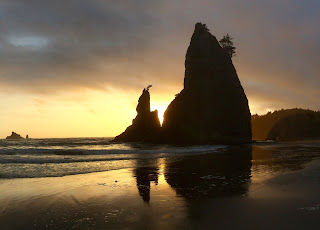On the brown wall above our brown couch, a canvas suspended on a nail reminds me I once visited the ocean.
More than once, actually.
When I was in single digits, my West Coast cousins and I danced over wavelets and built elaborate sand sculptures on the Oregon shore.
Other times, too, I’ve gazed wonderingly at the big waters — from the boardwalks of Atlantic City, from the confines of Alcatraz Island, from miles in the sky enroute to Germany.
In the most recent visit, the one captured in a rectangle on my wall, my family explored Rialto Beach, in the northwest corner of Washington State.
Barkless white trees lay like felled giants, tossed carelessly landward by errant waves.
Gray, perfectly round stones luxuriated in the sand, coyly coaxing caresses from passersby.
At the far end of the beach, lingering rock formations stood firm against the relentless waters that had worn away the rock of ages that once stood sentry on the ocean’s edge.Innocent clouds turned blue, then golden, then pink and purple as the sun finished its rounds, sending orange ribbons of water lapping against our toes.
A starfish — creepy, sinuous, a glove come to life — stretched a star arm down the side of a rock in a tide pool as my children gasped and pointed.
Our voices hovered metallically in the wide-open air, at once far away and intimate. The sun sank lower, and I pointed my camera and clicked, trying to snatch up the moment and pack it away for safekeeping.
Now, an enlargement of one of those photos hangs on my wall. Orange waves tug at the rock formations’ feet in the dimming light.
It’s pretty, sure.But it could be one of those photos that come with a store-bought frame, the glossy images you discard and replace with your own attempts to capture something far too large to fit in a box on the wall.
In the book I’m currently reading during my lunch break walks — “Zen and the Art of Motorcycle Maintenance,” by Robert M. Pirsig (it’s not really about the motorcycles) — a character gives up on trying to photograph the wide-open, wind-stirred landscape of the Great Plains.
“As soon as you put a border on it, it’s gone,” he muses.
So much of the life we encounter each day can only exist in uncatchable wholeness, impossible to shrink down to one little bite.
Nature’s beauty.
Man’s depravity.
The surrounding-ness of a city I love as I breathe it in from my perch on the roof of my workplace, moved to inexplicable tears by a curve of brick and the pigeon strutting on a metal fire escape.
The ideas in my head, the ones I long ago gave up trying to express because a tiny box of words could never hold them.
The inextricable interconnectedness of indifference and poverty and hopelessness and crime and heartache and addiction and trauma and clawing upward and sliding downward and hope in the darkness.
You can’t take a picture of big stuff.
You can try — you can say, “See, here, this small thing is that big thing.”
But it’s not.
It’s not even close.The angry fist, the rude comment, the obnoxious and politically charged tirade are only snippets of the whole.
The voices echoing off downtown buildings during a signs-held-high march ring beautiful in some ears, ugly in others, and capture only a fragment of a complex and wide-spreading set of truths that intermix and intermingle and burst the bounds of the labels that try, and fail, to contain them.
Snapshots give glimpses — crucial glimpses, for without them we see nothing — into issues and stories and truths too important to overlook.
That photo on my wall reminds me of my capacity to experience breathless awe at the perfectly round stone in my hand.
But what fits inside the box is only a fragment of the whole — a path inward, for those who choose to follow it.
My Maker doesn’t fit in a box any more than He fit on a tree.
The leather-bound Book on my shelf gives me a glimpse of the divine, a portal into ever-new discoveries of the heart-whopping realization that I can’t not be loved.
The cross on a silver chain around my neck gleams like a crack in the universe, a wholly inadequate but still precious representation of the epic battle between good and evil and acceptance and rejection and life and death when love resoundingly won, because love always wins.
Small is easy. We spout off in a faceless social media comment or snidely push aside the other side of the story, holding out our snapshots as indisputable truth.
But truth is what lies beyond the border of the picture, and you have to climb inside to see it.
People who have poked their heads inside Scripture and been bowled over by the oceans of love that lie therein should be first in line to look beyond the label, beyond the grubby face or criminal record, beyond difference or strangeness.
There’s more to our story than what others can see.
And there’s more to the snapshots around us. Infinitely more.
We just have to be willing to look for it.



No comments:
Post a Comment
Insert comments here! Life's more fun when we talk about it.